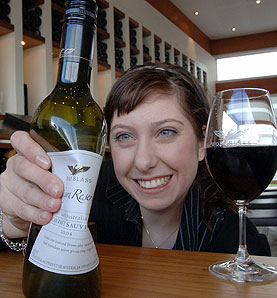 Plastic bottles are increasingly used for packaging wines that are ment for quick consumption. Since 2006, the Australian wine giant Wolff Blass sells several of its cheaper wines in bottles made from recycled PET (polyethylene). We wrote about this earlier. PET bottles are also used by some winemakers from the Loire. Jospeh Mollet (Sancerre) showed at the recent Salon des Vins de Loire in Angers plastic bottles with his Sauvignon Blanc ‘Destinea. Frederic Jacquet, chef de cave, sees (in the newspaper Ouest-France) only benefits. Because PET bottles are lighter, the same lorry can carry nearly nine thousand bottles extra. Not only the transport costs go down. The CO2 emissions are reduced to 68%, dixit Jacquet. Plastic bottles are also good news for the consumer: a plastic wine bottle weighs a lot less in the shopping bag. According to a study from 2007 of the American Association of Wine Economists, production and distribution of wine is responsible for one percent of global emissions of greenhouse gases (annually 6.3 billion tonnes). The CO2 impact of a plastic wine bottle is about half that of a glass bottle. The plastic bottles have a shelf life of about nine months and are therefore not suitable for high-end wines that need aging.
Plastic bottles are increasingly used for packaging wines that are ment for quick consumption. Since 2006, the Australian wine giant Wolff Blass sells several of its cheaper wines in bottles made from recycled PET (polyethylene). We wrote about this earlier. PET bottles are also used by some winemakers from the Loire. Jospeh Mollet (Sancerre) showed at the recent Salon des Vins de Loire in Angers plastic bottles with his Sauvignon Blanc ‘Destinea. Frederic Jacquet, chef de cave, sees (in the newspaper Ouest-France) only benefits. Because PET bottles are lighter, the same lorry can carry nearly nine thousand bottles extra. Not only the transport costs go down. The CO2 emissions are reduced to 68%, dixit Jacquet. Plastic bottles are also good news for the consumer: a plastic wine bottle weighs a lot less in the shopping bag. According to a study from 2007 of the American Association of Wine Economists, production and distribution of wine is responsible for one percent of global emissions of greenhouse gases (annually 6.3 billion tonnes). The CO2 impact of a plastic wine bottle is about half that of a glass bottle. The plastic bottles have a shelf life of about nine months and are therefore not suitable for high-end wines that need aging.
Copyright © 2024 | WordPress Theme by MH Themes
